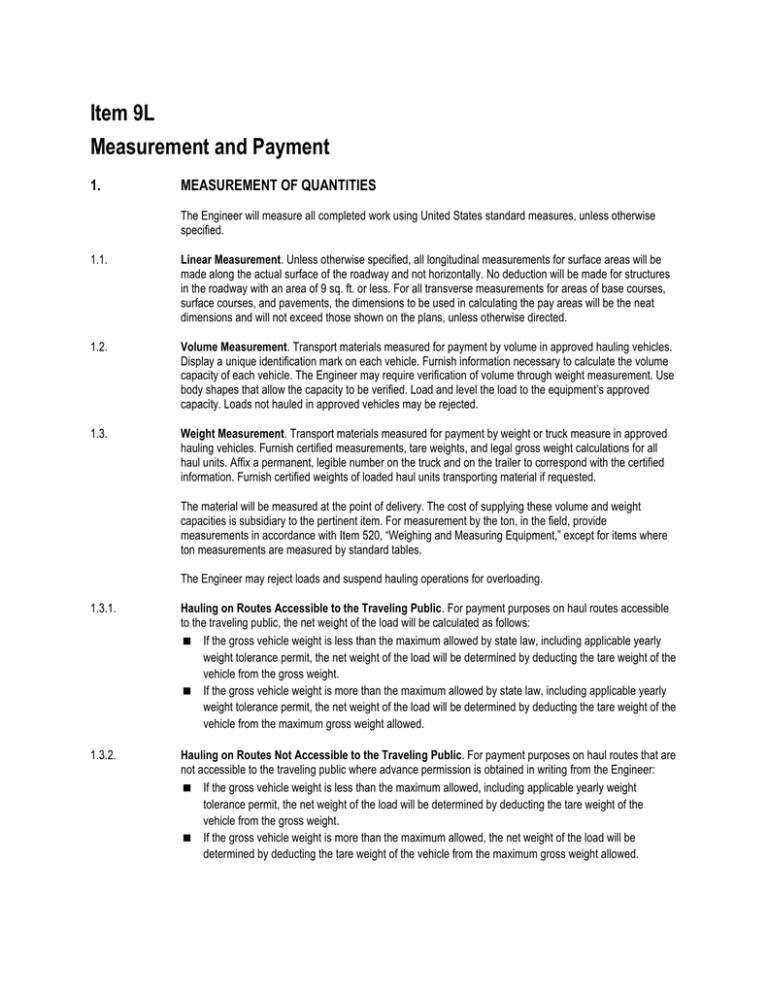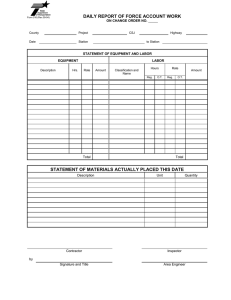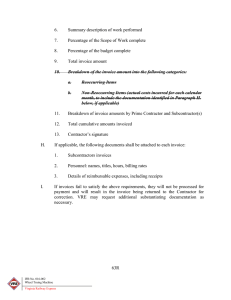9l.docx
advertisement

Item 9L Measurement and Payment 1. MEASUREMENT OF QUANTITIES The Engineer will measure all completed work using United States standard measures, unless otherwise specified. 1.1. Linear Measurement. Unless otherwise specified, all longitudinal measurements for surface areas will be made along the actual surface of the roadway and not horizontally. No deduction will be made for structures in the roadway with an area of 9 sq. ft. or less. For all transverse measurements for areas of base courses, surface courses, and pavements, the dimensions to be used in calculating the pay areas will be the neat dimensions and will not exceed those shown on the plans, unless otherwise directed. 1.2. Volume Measurement. Transport materials measured for payment by volume in approved hauling vehicles. Display a unique identification mark on each vehicle. Furnish information necessary to calculate the volume capacity of each vehicle. The Engineer may require verification of volume through weight measurement. Use body shapes that allow the capacity to be verified. Load and level the load to the equipment’s approved capacity. Loads not hauled in approved vehicles may be rejected. 1.3. Weight Measurement. Transport materials measured for payment by weight or truck measure in approved hauling vehicles. Furnish certified measurements, tare weights, and legal gross weight calculations for all haul units. Affix a permanent, legible number on the truck and on the trailer to correspond with the certified information. Furnish certified weights of loaded haul units transporting material if requested. The material will be measured at the point of delivery. The cost of supplying these volume and weight capacities is subsidiary to the pertinent item. For measurement by the ton, in the field, provide measurements in accordance with Item 520, “Weighing and Measuring Equipment,” except for items where ton measurements are measured by standard tables. The Engineer may reject loads and suspend hauling operations for overloading. 1.3.1. Hauling on Routes Accessible to the Traveling Public. For payment purposes on haul routes accessible to the traveling public, the net weight of the load will be calculated as follows: If the gross vehicle weight is less than the maximum allowed by state law, including applicable yearly weight tolerance permit, the net weight of the load will be determined by deducting the tare weight of the vehicle from the gross weight. If the gross vehicle weight is more than the maximum allowed by state law, including applicable yearly weight tolerance permit, the net weight of the load will be determined by deducting the tare weight of the vehicle from the maximum gross weight allowed. 1.3.2. Hauling on Routes Not Accessible to the Traveling Public. For payment purposes on haul routes that are not accessible to the traveling public where advance permission is obtained in writing from the Engineer: If the gross vehicle weight is less than the maximum allowed, including applicable yearly weight tolerance permit, the net weight of the load will be determined by deducting the tare weight of the vehicle from the gross weight. If the gross vehicle weight is more than the maximum allowed, the net weight of the load will be determined by deducting the tare weight of the vehicle from the maximum gross weight allowed. 2. PLANS QUANTITY MEASUREMENT Plans quantities may or may not represent the exact quantity of work performed or material moved, handled, or placed during the execution of the Contract. The estimated bid quantities are designated as final payment quantities, unless revised by the governing specifications or this article. If the quantity measured as outlined under “Measurement” varies by more than 5% (or as stipulated under “Measurement” for specific Items) from the total estimated quantity for an individual item originally shown in the Contract, an adjustment may be made to the quantity of authorized work done for payment purposes. When quantities are revised by a change in design approved by the Owner, by change order, or to correct an error on the plans, the plans quantity will be increased or decreased by the amount involved in the change, and the 5% variance will apply to the new plans quantity. If the total Contract quantity multiplied by the unit bid price for an individual item is less than $250 and the item is not originally a plans quantity item, then the item may be paid as a plans quantity item if the Engineer and Contractor agree in writing to fix the final quantity as a plans quantity. For Contracts with callout work and work orders, plans quantity measurement requirements are not applicable. 3. ADJUSTMENT OF QUANTITIES The party to the Contract requesting the adjustment will provide field measurements and calculations showing the revised quantity. When approved, this revised quantity will constitute the final quantity for which payment will be made. Payment for revised quantity will be made at the unit price bid for that item, except as provided for in Article 4.4., “Changes in the Work.” 4. SCOPE OF PAYMENT Payment of the Contract unit price is full compensation for all materials, equipment, labor, tools, and supplies necessary to complete the item of work under the Contract. Until final acceptance in accordance with Article 5.12., “Final Acceptance,” assume liability for completing the work according to the Contract documents and any loss or damage arising from the performance of the work or from the action of the elements, infringement of patent, trademark, or copyright, except as provided elsewhere in the Contract. The Owner will only pay for material incorporated into the work in accordance with the Contract. Payment of progress estimates will in no way affect the Contractor’s obligation under the Contract to repair or replace any defective parts in the construction or to replace any defective materials used in the construction and to be responsible for all damages due to defects if the defects and damages are discovered on or before final inspection and acceptance of the work. 5. PROGRESS PAYMENTS The Engineer will prepare a monthly estimate of the amount of work performed, including materials in place. Incomplete items of work may be paid at an agreed upon percentage as approved. Payment of the monthly estimate is determined at the Contract item prices less any withholdings or deductions in accordance with the Contract. Progress payments may be withheld for failure to comply with the Contract. 6. PAYMENT FOR MATERIAL ON HAND (MOH) If payment for MOH is desired, request compensation for the invoice cost of acceptable nonperishable materials that have not been used in the work before the request, and that have been delivered to the work location or are in acceptable storage places. Nonperishable materials are those that do not have a shelf life or whose characteristics do not materially change when exposed to the elements. Include only materials that have been sampled, tested, approved, or certified, and are ready for incorporation into the work. Only materials which are completely constructed or fabricated on the Contractor’s order for a specific Contract and are so marked and on which an approved test report has been issued are eligible. Payment for MOH may include the following types of items: concrete traffic barrier, precast concrete box culverts, concrete piling, reinforced concrete pipe, and illumination poles. Any repairs required after fabricated materials have been approved for storage will require approval of the Engineer before being made and will be made at the Contractor’s expense. Include only those materials that have an invoice cost of at least $1,000 in the request for MOH payment. If the request is acceptable, the Engineer will include payment for MOH in a progress payment. Payment for MOH does not constitute acceptance of the materials. Payment will not exceed the actual cost of the material as established by invoice, or the total cost for the associated item less reasonable placement costs, whichever is less. Materials for which the Contractor does not have a paid invoice within 60 days will not be eligible for payment and will be removed from the estimate. Payment may be limited to a portion of the invoice cost or unit price if shown elsewhere in the Contract. Payment for precast products fabricated or constructed by the Contractor for which invoices or freight bills are not available may be made based on statements of actual cost. Submit the request on forms provided by the Owner. These forms may be electronically reproduced, provided they are in the same format and contain all the required information and certifications. Continue to submit monthly MOH forms until the total value of MOH is $0. By submitting a request for MOH payment, the Contractor expressly authorizes the Owner to audit MOH records, and to perform process reviews of the record-keeping system. If the Owner determines noncompliance with any of the requirements of this provision, the Owner may exclude payment for any or all MOH for the duration of the Contract. Maintain all records relating to MOH payment until final acceptance. Provide these records to the Engineer upon request. 7. PAYMENT FOR EXTRA WORK AND FORCE ACCOUNT METHOD Payment for extra work directed, performed, and accepted will be made in accordance with Article 4.4., “Changes in the Work.” Payment for extra work may be established by agreed unit prices or by Force Account Method. Agreed unit prices are unit prices that include markups and are comparable to recent bid prices for the same character of work. These unit prices may be established without additional breakdown justification. When using Force Account Method, determine an estimated cost for the proposed work and establish labor and equipment rates and material costs. Maintain daily records of extra work and provide copies of these records daily, signed by the Contractor’s representative, for verification by the Engineer. Request payment for the extra work no later than the 10th day of the month following the month in which the work was performed. Include copies of all applicable invoices. If the extra work to be performed has an estimated cost of less than $10,000, submit for approval and payment an invoice of actual cost for materials, equipment, labor, tools, and incidentals necessary to complete the extra work. 7.1. Markups. Payment for extra work may include markups as compensation for the use of small tools, overhead expense, and profit. 7.1.1. Labor. Compensation will be made for payroll rates for each hour that the labor, foremen, or other approved workers are actually engaged in the work. In no case will the rate of wages be less than the minimum shown in the Contract for a particular category. An additional 25% of this sum will be paid as compensation for overhead, superintendence, profit, and small tools. 7.1.2. Insurance and Taxes. An additional 55% of the labor cost, excluding the 25% compensation provided in Section 9.7.1.1., “Labor,” will be paid as compensation for labor insurance and labor taxes including the cost of premiums on non-project-specific liability (excluding vehicular) insurance, workers compensation insurance, Social Security, unemployment insurance taxes, and fringe benefits. 7.1.3. Materials. Compensation will be made for materials associated with the work based on actual delivered invoice costs, less any discount. An additional 25% of this sum will be paid as compensation for overhead and profit. 7.1.4. Equipment. Payment will be made for the established equipment hourly rates for each hour that the equipment is involved in the work. An additional 15% of this sum will be paid as compensation for overhead and profit not included in the rates. Transportation cost for mobilizing equipment will be included if the equipment is mobilized from an off-site location. 7.1.4.1. Contractor-Owned Equipment. For Contractor-owned machinery, trucks, power tools, or other equipment, use the FHWA rental rates found in the Rental Rate Blue Book multiplied by the regional adjustment factor and the rate adjustment factor to establish hourly rates. Use the rates in effect for each section of the Rental Rate Blue Book at the time of use. If a rate has not been established for a particular piece of equipment in the Rental Rate Blue Book, the Engineer will allow a reasonable hourly rate. This price will include operating costs. Payment for equipment will be made for the actual hours used in the work. The Owner reserves the right to withhold payment for low production or lack of progress. Payment will not be made for time lost for equipment breakdowns, time spent to repair equipment, or time after equipment is no longer needed. If equipment is used intermittently while dedicated solely to the work, payment will be made for the duration the equipment is assigned to the work but no more than 8 hours will be paid during a 24-hour day, nor more than 40 hours per week, nor more than 176 hours per month, except when time is computed using a six-day or seven-day workweek. When using a six-day workweek, no more than 8 hours will be paid during a 24-hour day, nor more than 48 hours per week, nor more than 211 hours per month. When using a seven-day workweek, no more than 8 hours will be paid during a 24-hour day, nor more than 56 hours per week, nor more than 246 hours per month. 7.1.4.2. Equipment Not Owned by the Contractor. For equipment rented from a third party not owned by the Contractor, payment will be made at the invoice daily rental rate for each day the equipment is needed for the work. The Owner reserves the right to limit the daily rate to comparable Rental Rate Blue Book rates. When the invoice specifies that the rental rate does not include fuel, lubricants, repairs, and servicing, the Rental Rate Blue Book hourly operating cost for each hour the equipment is operated will be added. When the invoice specifies equipment operators as a component of the equipment rental, payment will be made at the invoice rate for each operator for each day the equipment is needed for the work. 7.1.4.3. Standby Equipment Costs. Payment for standby equipment will be made in accordance with Section 9.7.1.4., “Equipment,” except that: 7.1.4.3.1. Contractor-Owned Equipment. For Contractor-owned machinery, trucks, power tools, or other equipment: Standby will be paid at 50% (to remove operating cost) of the FHWA rental rates found in the Rental Rate Blue Book multiplied by the regional adjustment factor and the rate adjustment factor. Standby costs will not be allowed during periods when the equipment would have otherwise been idle. 7.1.4.3.2. Equipment Not Owned by the Contractor. For equipment rented from a third party not owned by the Contractor: Standby will be paid at the invoice daily rental rate, excluding operating cost, which includes fuel, lubricants, repairs, and servicing. The Owner reserves the right to limit the daily standby rate to comparable FHWA rental rates found in the Rental Rate Blue Book multiplied by the regional adjustment factor and the rate adjustment factor. Standby will be paid for equipment operators when included on the invoice and equipment operators are actually on standby. Standby costs will not be allowed during periods when the equipment would have otherwise been idle. 7.1.5. Subcontracting. An additional 5% of the actual invoice cost will be paid to the Contractor as compensation for administrative cost, superintendence, and profit. 7.1.6. Law Enforcement. An additional 5% of the actual invoice cost will be paid as compensation for administrative costs, superintendence, and profit. 7.1.7. Railroad Flaggers. An additional 5% of the actual invoice cost will be paid as compensation for administrative cost, superintendence, and profit. 7.1.8. Bond Cost. An additional 1% of the total compensation provided in Article 9.7., “Payment for Extra Work and Force Account Method,” will be paid for the increase in bond. 8. RETAINAGE The Owner will not withhold retainage on the Contractor. The Contractor may withhold retainage on subcontractors in accordance with state and federal regulations. 9. PAYMENT PROVISIONS FOR SUBCONTRACTORS For the purposes of this article only, the term subcontractor includes suppliers and the term work includes materials provided by suppliers at a location approved by the Engineer. These requirements apply to all tiers of subcontractors. Incorporate the provisions of this article into all subcontract or material purchase agreements. Pay subcontractors for work performed within 10 days after receiving payment for the work performed by the subcontractor. Also, pay any retainage on a subcontractor’s work within 10 days after satisfactory completion of all of the subcontractor’s work. Completed subcontractor work includes vegetative establishment, test, maintenance, performance, and other similar periods that are the responsibility of the subcontractor. For the purpose of this section, satisfactory completion is accomplished when: the subcontractor has fulfilled the Contract requirements of both the Owner and the subcontract for the subcontracted work, including the submittal of all information required by the specifications and the Owner; and the work done by the subcontractor has been inspected, approved, and paid by the Owner. Provide a certification of prompt payment in accordance with the Owner’s prompt payment procedure to certify that all subcontractors and suppliers were paid from the previous months payments and retainage was released for those whose work is complete. Submit the completed form each month and the month following the month when final acceptance occurred at the end of the project. The inspection and approval of a subcontractor’s work does not eliminate the Contractor’s responsibilities for all the work as defined in Article 7.17., “Contractor’s Responsibility for Work.” The Owner may pursue actions against the Contractor, including withholding of estimates and suspending the work, for noncompliance with the subcontract requirements of this section upon receipt of written notice with sufficient details showing the subcontractor has complied with contractual obligations. 10. FINAL PAYMENT When the Contract has been completed, all work has been approved, final acceptance has been made in accordance with Article 5.12., “Final Acceptance,” and Contractor submittals have been received, the Engineer will prepare a final estimate for payment showing the total quantity of work completed and the money owed the Contractor. The final payment will reflect the entire sum due, less any sums previously paid.

